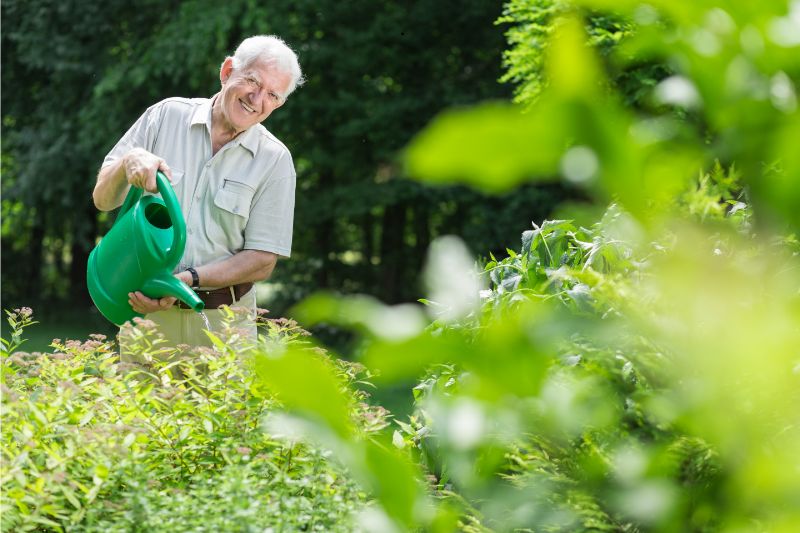
Summer Garden Checklist – Keeping Your Plants Thriving All Season
Summer gardening necessitates a diligent focus on an array of undertakings to guarantee the vitality and well-being of your green space amidst the warmth and periods of rapid growth. Adhering to this extensive checklist empowers you to effectively manage crucial upkeep tasks and revel in a thriving garden throughout the duration of the summer season.
Spread Mulch
Spreading mulch emerges as a pivotal task in summer garden care. Covering up the soil with 2-inch mulch made of shredded wood, pine straw or a combination of the organic substances is similar to putting a shield on it. Mulch is constantly ensuring that the temperature of the soil is regulated; cooler during scorching summer days and warmer during chilly nights.
Furthermore, it diminishes moisture depletion via evaporation, preserving water and guaranteeing adequate hydration for plant roots. As the mulch decomposes, it enhances soil fertility by infusing it with essential nutrients, thereby bolstering its overall vigour and productivity.
Pull Up Weeds
Weeding remains a constant duty in all gardens, but it gains added significance during the summer period when weeds flourish swiftly. Consistent elimination of weeds averts their competition with your plants for vital resources like water, nutrients, and sunlight.
Addressing weeds while they’re still small and easy to manage is crucial, as letting them mature could escalate into larger weed issues down the line. Hand-pulling weeds or employing suitable gardening tools guarantees their complete removal, significantly reducing the risk of regrowth.
Add Color with Summer Annuals
As the summer heat intensifies, numerous spring-blooming annuals start to wane. Substituting them with lively summer annuals keeps your garden vibrant. Species like angelonia, lantana, ageratum, and zinnia flourish in the season’s warmth and sunlight, offering uninterrupted blossoms until autumn arrives. When choosing summer annuals, ponder over factors like sunlight preferences, watering demands, and suitability to your current garden design, ensuring a cohesive and aesthetically pleasing arrangement.
Plant Summer-Blooming Bulbs
Summer-flowering bulbs inject an aura of thrill and expectancy into the garden, unfurling their breathtaking blooms amidst the hottest months of the year. Esteemed varieties such as calla lilies, cannas, dahlias, and gladioli boast an array of colour options, forms, and shapes.
When planting these bulbs, prioritise ample sunlight exposure and soil with efficient drainage for optimal growth. Ponder integrating them into current flower plots or crafting specialised bulb gardens to create a captivating centrepiece.
Pinch Back Mums and Late Perennials
Preserve the vigour and aesthetics of tardy-blooming perennials, including mums, sedums, and asters, by conscientiously pinching back emerging foliage. Pinching entails snipping the tips of stems to stimulate dense growth and deter elongation. This method fosters the emergence of lateral shoots, yielding more compact plants adorned with profuse blossoms. By implementing this practice on late perennials at the onset of summer, you can uphold their resilience and splendour throughout the duration of the season.
Remove Faded Flowers
Eliminating faded flowers through deadheading is a straightforward yet potent technique for extending the blooming duration and upholding the visual allure of your garden. By thwarting seed formation, deadheading redirects plant energy towards generating fresh blossoms, thereby prolonging the flowering phase.
Frequently check your garden for withered flowers, especially those annuals and perennials that are prone to self-seeding. The act of deadheading not only makes your green space more pleasing to the eye but also reduces to a bare minimum the amount of cleanup and pruning work you need to do later in the growing season.
Watch for Pests and Diseases
Constant monitoring and tracking are necessary to prevent the invasion of pests and the spread of disease in the summer garden you’re taking care of. Look at your plantings attentively for possible vermins like aphids, caterpillars, and spider mites or fungal diseases like powdery mildew and black spots.
Early identification enables swift action, be it through the assistance of natural predators, organic solutions, or precise treatments. Embracing effective horticultural customs, including optimal plant spacing, adequate air circulation, and consistent cleanliness, serves to mitigate the likelihood of pest and disease complications.
Water Your Garden
Adequate watering is crucial for your garden’s well-being, especially amid the intense heat and dryness of summer. Typically, most garden plants need about 1 inch of water per week, directed straight to the root area for effective uptake. Opt for early morning watering to lessen evaporation and lower the chances of fungal infections. Think about employing drip irrigation or soaker hoses for precise watering, and steering clear of foliage dampness to prevent leaf ailments. Adapt your watering routine according to weather forecasts, plant requirements, and soil moisture levels to uphold ideal hydration levels throughout the season.
Harvest Vegetables
Utilise the full potential of your summer vegetable plot by gathering crops when they reach their prime maturity. Consistent harvesting fosters ongoing plant productivity, averting excessive ripening and guaranteeing a consistent stream of newly picked yields. Check each day for ripe fruits and veggies, encompassing tomatoes, cucumbers, peppers, and beans, and swiftly collect them to savour their full flavour and nutritional perks. Make certain to gather veggies before they surpass the threshold of excessive ripeness, as overly ripe fruits might entice pests and jeopardise the plants’ overall vigour.
Start a Fall Vegetable Garden
Embrace the forthcoming cooler months by initiating a fall vegetable garden, amplifying your yield span and enhancing your garden’s efficiency. Opt for cool-season varieties like broccoli, lettuce, spinach, and kale, which flourish in the gentler autumn temperatures, yielding an abundance of crisp greens and veggies throughout the chillier periods.
Kickstart the process by germinating seeds indoors or directly planting them in your garden during late summer, ensuring ample time for them to reach maturity before the onset of frost. Employ tactics like succession planting and season-stretching methods, such as row covers and cold frames, to further lengthen your harvest window and extend your gardening season.
Conclusion
In conclusion, by adhering to this thorough checklist and integrating tailored strategies and insights according to your garden’s requirements, you guarantee the flourishing of your plants throughout the summer months. This results in the creation of a splendid and fruitful outdoor haven, providing you with ample enjoyment.
You May Also Like

Exploring the Latest Trends and Techniques in Lip Injections
November 2, 2023
Who Should Consider Buying Mirrorless Cameras? The Ultimate Guide
May 30, 2023


